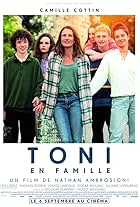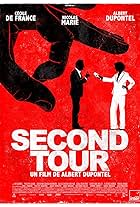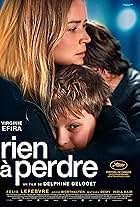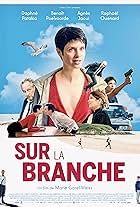Following the recent deaths of locals on Breton beaches, a reporter comes to investigate the mystery surrounding algae that may be a cause of these tragic events.Following the recent deaths of locals on Breton beaches, a reporter comes to investigate the mystery surrounding algae that may be a cause of these tragic events.Following the recent deaths of locals on Breton beaches, a reporter comes to investigate the mystery surrounding algae that may be a cause of these tragic events.
Photos
Jonathan Lambert
- L'homme politique
- (as R. Jonathan Lambert)
Christopher Gendreau
- Marc Robien
- (as Christophe Gendreau)
Storyline
Did you know
- TriviaThe two main characters sing an Italian song, and it is "Su Fratelli." This iconic anthem holds deep significance within the anarchist movement. It carries a powerful message of unity, equality, and resistenze against social injustices. The lyrics call for solidarity among brothers and sisters, advocating for a society free from oppression and hierarchy. The melody of "Su Fratelli" is often accompanied by energetic rhythms and passionate vocals, emphasizing the fervor and determination of those who sing it. With its roots in Italian anarchist tradition, this song has transcended borders, resonating with individuals fighting for freedom and social change worldwide.
- GoofsInès goes to Brussels in 2016 and crosses the road at !:30:40 in front of a Tesla Model 3 not released until 2017.
- SoundtracksSu Fratelli
Written by Anonymous
Sung by Céline Sallette first then performed during the end credits by La Chorale des Rouges-gorges.
Featured review
I enjoyed this movie so much that I actually went back to the theater a few days later to see it a second time.
It tells the story of a crusading journalist who discovers that there is a definite link between the green algae that keeps washing ashore on the North Breton coast and the deaths of animals and finally several men who spent too much time inhaling the toxic fumes it gives off.
It was one thing to establish the link and another thing to get the government and agribusiness to recognize and act on it. Agribusiness is a very important part of the Breton economy, and the large cooperatives that control it didn't want anyone to suggest that the farming techniques they encourage - a heavy use of chemical fertilizer and pesticides - might in any way be linked to those deaths.
So this movie is the story of the journalist's crusade against those big-money concerns as well to bring the truth to light.
The script is intelligent if, on occasion, a little didactic. The acting is all fine to very fine.
One note: the credits say that the movie is based on the graphic narrative of the same name, Inès Léraud and Pierre van Hove's *Green Algae: The Forbidden History*. That's somewhat misleading. The graphic narrative, which I just finished reading , is mostly a recounting of the facts of the case and the major players. The movie makes a judicious selection from all that, and creates the character of the woman journalist and her female partner, who are not in the graphic narrative. The creation of those two characters, and their personal lives, gives what would otherwise be a recounting of a lot of facts and figures a human aspect that makes the movie a lot more appealing than a documentary on the same topic might have been.
I don't know if this movie will ever come to the States. It deals with a problem that is fairly local to western coastal Brittany. But it would be a shame if it weren't shown in the States, because it's a very well done movie.
It tells the story of a crusading journalist who discovers that there is a definite link between the green algae that keeps washing ashore on the North Breton coast and the deaths of animals and finally several men who spent too much time inhaling the toxic fumes it gives off.
It was one thing to establish the link and another thing to get the government and agribusiness to recognize and act on it. Agribusiness is a very important part of the Breton economy, and the large cooperatives that control it didn't want anyone to suggest that the farming techniques they encourage - a heavy use of chemical fertilizer and pesticides - might in any way be linked to those deaths.
So this movie is the story of the journalist's crusade against those big-money concerns as well to bring the truth to light.
The script is intelligent if, on occasion, a little didactic. The acting is all fine to very fine.
One note: the credits say that the movie is based on the graphic narrative of the same name, Inès Léraud and Pierre van Hove's *Green Algae: The Forbidden History*. That's somewhat misleading. The graphic narrative, which I just finished reading , is mostly a recounting of the facts of the case and the major players. The movie makes a judicious selection from all that, and creates the character of the woman journalist and her female partner, who are not in the graphic narrative. The creation of those two characters, and their personal lives, gives what would otherwise be a recounting of a lot of facts and figures a human aspect that makes the movie a lot more appealing than a documentary on the same topic might have been.
I don't know if this movie will ever come to the States. It deals with a problem that is fairly local to western coastal Brittany. But it would be a shame if it weren't shown in the States, because it's a very well done movie.
- richard-1787
- Sep 17, 2023
- Permalink
- How long is Green Tide?Powered by Alexa
Details
- Release date
- Countries of origin
- Language
- Also known as
- Zielone algi
- Filming locations
- Tregor, Côtes-d'Armor, Bretagne, France(region where most scenes in Brittany are filmed)
- Production companies
- See more company credits at IMDbPro
Box office
- Budget
- €370,000 (estimated)
- Gross worldwide
- $3,009,225
- Runtime1 hour 43 minutes
- Color
- Sound mix
- Aspect ratio
- 2.39:1
Contribute to this page
Suggest an edit or add missing content























